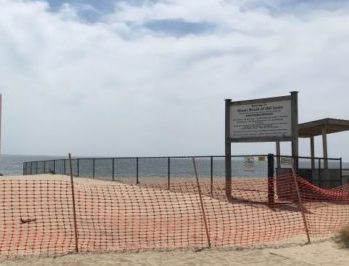
I will introduce this topic by acknowledging the courage of Ms. Kathleen Tracy and her co-plaintiffs, who have seen the most recent beach access case against the Miami Beach Association (MBA) through to its conclusion. That specific lawsuit, which really began with a fence in 2016, ultimately required more than six years of effort and anguish; and certainly, some considerable expense.
There has been substantial media coverage of this and the earlier, nearly identical cases, so I thought it would be worthwhile to devote this “View” to an impartial chronicle of Old Lyme’s beach access skirmishes, based on that coverage — a post mortem, if you will.
My objectives are to provide a basic understanding of how Connecticut has ensured the public’s access to its beaches, and to review 70 years of the Sound View / MBA experience.
Prologue:
It has been more than a century and a quarter since H. J. Hilliard deeded the property then referred to as “Long Island Avenue”, and now comprising the whole of Sound View Beach and the adjacent Miami Beach, to the “unorganized general public for its perpetual use”. Despite that, members of the MBA have erected fences over the years to impede entry from Sound View, only to be repeatedly ordered to take them down.
I begin this essay with a review of what I believe are the key events that played a role in assuring the public’s access to beaches in Connecticut and then turn to an Old Lyme “play-by-play”.
Public Access to Connecticut Beaches:
One cannot review this topic without considering the endeavors of Connecticut activist, Ned Coll, who founded an anti-poverty and social justice agency in Hartford, the Revitalization Corps, in memory of assassinated President John F. Kennedy. Ned presented himself in every conflict as the “everyman”.
He was shocked by both the poverty and racism that he felt had kept impoverished minority residents isolated in Hartford; and the apparent indifference shown by those living in the suburbs. He wanted to confront the reality of that city vs. suburb divide, and determined that the best place to demonstrate it was probably at the private beaches in the more affluent shoreline communities, that in the late -1960s, were nearly all in private hands or limited to town residents.
A master showman, who had the willing support of the media, Coll began gathering busloads of children from Hartford’s North End in the early 1970s; and then proceeded to Long Island Sound for a day at the beach. He challenged local officials to keep the kids off the sand and out of the water. To publicize his efforts, he walked the shoreline from Old Lyme to Greenwich, even landing on a few beaches in a rubber raft. He became the face and catalyst of the contentious issue of blocking public access to Long Island Sound.
He continued his beach trips for several years; and managed to keep the state focused on his cause. Nonetheless, the individual who got the beaches opened to the public was a Rutgers law student, Brenden Leydon, who was stopped by security while jogging on the Greenwich Point Park beach. Leydon sued the town and won. Ned Coll provided expert testimony.
In 2001, in “Leydon vs. Greenwich”, the Connecticut Supreme Court overturned the Greenwich ordinance that banned non-residents from entering the park and its beach. The court found that the beach constituted a public forum and non-residents’ access to it was protected under the First Amendment, which guarantees a citizen’s rights to free speech and association; and informed the towns on the Connecticut shoreline that they could not prohibit access to the beachfront.
Later, in 2019, the Department of Energy and Environmental Protection ordered the Shenecossett Beach Club in Groton to remove a portion of the fence it had placed along a stone jetty and a sign that said “Members only.” The legal basis for this order was that the Beach Club was violating the Public Trust Doctrine (PTD), which holds that private ownership ends at the mean high-water-line and the general public can use the area of the beach that is waterward of that line, i.e., coastal states hold the submerged lands and waters waterward of the mean high-water-line in trust for the public.
The doctrine, which is found primarily in state Common Law, is one of the main underpinnings of environmental law in the United States and requires states to manage certain natural resources for the benefit of the general public. Public Trust Doctrine provides assurance that they may freely use these lands and waters, whether they are beach, rocky shore, or open water. The PTD has been re-confirmed by the CT Supreme Court in a line of cases that date back nearly 100 years.
The Sound View Beach Border Chronicles:

The MBA, a private beach community, was founded in 1949. They installed their first beach boundary fence in 1952 to mark the end of the Sound View public beach and the beginning of “private” Miami Beach.
Then, in early 1953, the New London District Superior Court, in a decision on “Rose Vitello et al, v. Nunzio Corsino and Miami Beach Association”, issued an injunction that prohibited the fence, proclaiming that the entire length of Sound View and Miami Beaches must remain open to the public, as spelled out by H. J. Hilliard.
The “New London Day” reported that the MBA put up another fence in the late-1980s, only to be “promptly” removed by the Town. However, then First Selectwoman Bonnie Reemsnyder stated, “the town has concerns about the fence, but its attorneys have advised against taking legal action”; and so, “it would now be up to members of the public to challenge the fence, just as they did in the early 1950s.”
In 2016, near the end of the beach season, the MBA put up a chain-link fence and levied a “clean beach fee” that would be charged at an entry point. Sound View resident Kathleen Tracy challenged the legality of the fence and fee in 2018 in “Kathleen Tracey et al v. Miami BeachAssociation”.
In July, 2019, Superior Court Judge Kimberly A. Knox heard testimony and ruled that, “Nothing but the recent imposition of a fee has changed since1953, when an injunction was issued; making the entire length of Sound View and Miami Beaches open to the public.” The fence must come down and the fee be abolished, although the fence was allowed to remain while an appeal was pending.
A few weeks ago, in mid-April; and after the Connecticut Supreme Court refused to review the Superior Court’s decision (above), the fence was again removed. In full, Knox ruled that the Association is prohibited, “now and hereinafter,” from maintaining or establishing any other fence or boundary, and from charging fees and issuing permits for the use of the beach.
Leave Nothing Behind but your Footprints:
I believe that the fundamental issue that prompted the MBA’s construction of fences and the 2016 “clean beach” fee was the regrettably bad behavior that some of the “unorganized general public” exhibited while visiting the beach.
The MBA described a mess that went well beyond the little bit of litter and trash left behind, using the word, “Filthy!”and describing rude and disrespectful behavior; and inappropriate interpersonal behaviors that are better indulged in private.
Sound View Beach apparently witnessed the same, but also noted a significant increase in calls for police service.The MBA reported that they spend about $40,000 to $45,000 per year on beach security, and $13,000 on cleaning the beach, while the town covers only about $20,000.
A Meeting of the Minds:
The leaders of the two beach communities met with Old Lyme’s Board of Selectmen in July, 2021 and presented data describing the problems at the two beaches from an informal “task force”; and suggested some possible solutions, which included making it more expensive for out-of-towners to park at the beach by increasing rates in town-owned parking, and raising permit fees for private parking lots.
First Selectman Timothy Griswold requested that the two leaders put some action steps in writing with quantifying data to be presented at a future meeting. Then-Selectwoman Mary Jo Nosal said the informal “task force” should be an official group that represents the residents of Old Lyme. I am not certain whether either of those requests went any further.
Author’s Thoughts:
Conflicts regarding beach access are not unique to Old Lyme. Public access advocates are worried about a new attack on the right of way to the beaches of the 1.5-mile-long Napatree Point in Watch Hill. Officials of the Watch Hill Fire District, which owns a portion lot of the Point, have recently put the Town on notice that they do not accept the validity of a 2008 town resolution enshrining into law “a right of way for access by the public to pass and re-pass to and from Napatree Point in perpetuity”.
Watch Hill runs the risk of being only known as the home of Taylor Swift, who, I am told, sings songs.
In closing, a few words on sportsmanship. Some of my life has involved ice hockey programs for boys and girls from the newest skaters through high school and college. The games are intense and emotions can run high. At the games end, and regardless of the outcome, both teams will skate the length of the rink in parallel lines, bumping gloves, with a “good game!”
In contrast, “The Day” reported that when the fence came down for the last time, Ms. Tracy extended her hand to the President of MBA’s Board of Governors and said, “Let’s just move on; can we do that?”
He ignored the gesture.
In the NFL, if a player is flagged for unsportsmanlike conduct, the penalty is 15 yards, and an automatic first down, when committed by the defense.
Robert Frost claimed that “good fences make good neighbors”. Well, maybe in New Hampshire, but in Old Lyme?
Well, let’s see …
Sources:
- Burian,H. “Old Lyme woman takes legal action to rid Miami Beach of Fence”. NBC-CT. 08/23/2017.
- Collins,D. “War over public access to Napatree Point heats up in Westerly”. New London Day. 04/19/ 2023
- Condon, T. “Edward T. “Ned” Coll dies; Hartford activist fought racism, poverty, and closed beaches”. CT Mirror. 12/19/2022
- Crawford, A. “Racism Kept Connecticut’s beaches white Up through the 1970s”. Smithsonian Magazine. July,2018
- Drelich, K. “DEEP: portion of Shenecossett Beach Club fence must be removed”. New London Day. 10/26/2019
- Hewett, C. “Fence to come down at Sound View Beach after court ruling”. The CT Examiner. 04/12/2023.
- Howard, L. “Miami Beach fence comes down after court ruling”. New London Day. 04/13/2023
- Kahrl, A. W. “Free the beaches: the story of Ned Coll and the battle for America’s most exclusive shoreline.” Yale University Press. 2018
- Regan, E. “Old Lyme beach officials recommend higher parking fees to discourage out-of-towners”. New London Day. 07/07/2021
- Regan, E. “Closing time at issue in Sound View parking lot”. New London Day. 07/20/2021
- Florin, K. “Debate over beach rights heats up in Old Lyme.” New London Day. 07/03/2017.
- Florin, K. “Sound View resident takes legal step to fight Miami Beach fence in Old Lyme.” New London Day. August 21, 2017.
- Florin, K. “Judge: Old Lyme beach fence must come down.” New London Day. 01/14/ 2020.
Editor’s Note: This is the opinion of Thomas D. Gotowka.
About the author: Tom Gotowka is a resident of Old Lyme, whose entire adult career has been in healthcare. He will sit on the Navy side at the Army/Navy football game. He always sit on the crimson side at any Harvard/Yale contest. He enjoys reading historic speeches and considers himself a scholar of the period from FDR through JFK. A child of AM Radio, he probably knows the lyrics of every rock and roll or folk song published since 1960. He hopes these experiences give readers a sense of what he believes “qualify” him to write this column.
Great “View”